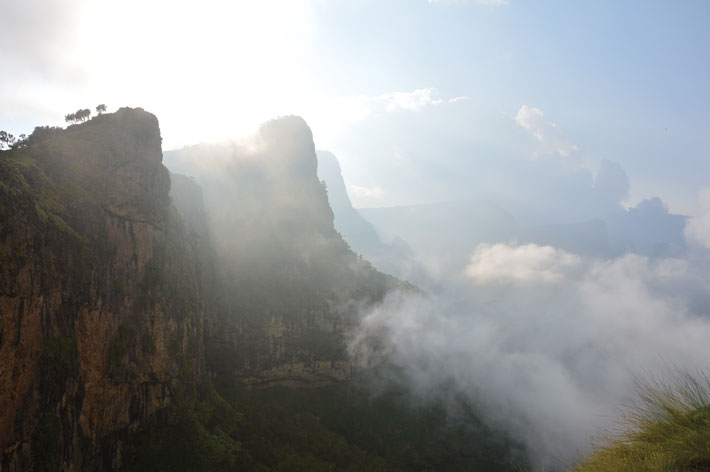 Along the banks of the Gerzeman River, which runs through a valley in northern Ethiopia’s Semien Mountains, sits the village of Semien Menata. Too small and remote to appear on most maps, it is reachable only by walking paths from nearby larger villages. Today Semien Menata is dotted with small wooden homes, flocks of animals, and agricultural fields typical of the region. Scattered about, however, lies evidence of the village’s former inhabitants: Ethiopian Jews known as the Beta Israel who trace their origins to Biblical times, but whose exact roots remain unclear.
Along the banks of the Gerzeman River, which runs through a valley in northern Ethiopia’s Semien Mountains, sits the village of Semien Menata. Too small and remote to appear on most maps, it is reachable only by walking paths from nearby larger villages. Today Semien Menata is dotted with small wooden homes, flocks of animals, and agricultural fields typical of the region. Scattered about, however, lies evidence of the village’s former inhabitants: Ethiopian Jews known as the Beta Israel who trace their origins to Biblical times, but whose exact roots remain unclear.
Ethiopia’s Jewish community, which settled throughout the rugged north of the country where it was a minority in a mostly Christian kingdom, is first documented in fourteenth-century sources. The Beta Israel consisted of farmers and artisans as well as a religious hierarchy including a class of ascetic high priests, or meloksewoch, and lay priests, or qesoch, in Ge‘ez, a Semitic tongue that became the main liturgical language of the Beta Israel. Meloksewoch lived separately and adhered to strict purity laws that prohibited physical contact with the laity. Both types of priest performed animal sacrifices according to Biblical decree, a practice that lasted into the twentieth century in Ethiopia, long after it had been abandoned in the rest of the Jewish world. The meloksewoch are the only known example of an ascetic Jewish movement after the first century A.D., when sects such as the Essenes, who are generally credited with writing some of the Dead Sea Scrolls, faded away with the rise of the Roman Empire.
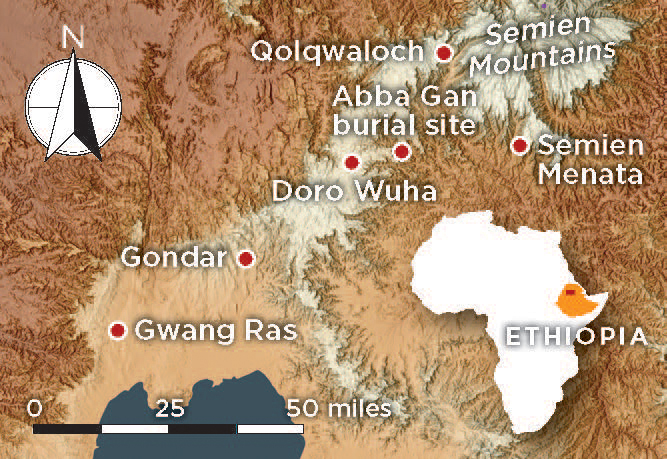 Currently, a team led by archaeologist Bar Kribus of Ruhr University Bochum and Sophia Dege-Müller of the University of Hamburg is trying to learn more about the community’s obscure history and unique practices. Team members have drawn on a combination of archaeological survey, texts, and the oral history and memories of living members of the Beta Israel, whose population of 100,000 fled to Israel en masse beginning in the 1980s to escape war and famine. Between 2015 and 2018, Kribus and Dege-Müller’s team surveyed 17 Beta Israel villages, focusing on locations associated with the meloksewoch. The researchers have found evidence of the community’s pilgrimage practices, their hardships, and events known from oral and written history. They have also explored the institution of the ascetic priesthood, which played a key leadership role and was likely responsible for the development of aspects of the group’s liturgy and for canonizing its sacred texts. “Since this project, the work on this group’s history suddenly has become much more grounded,” says Steven Kaplan, a historian who studies the Beta Israel at the Hebrew University of Jerusalem.
Currently, a team led by archaeologist Bar Kribus of Ruhr University Bochum and Sophia Dege-Müller of the University of Hamburg is trying to learn more about the community’s obscure history and unique practices. Team members have drawn on a combination of archaeological survey, texts, and the oral history and memories of living members of the Beta Israel, whose population of 100,000 fled to Israel en masse beginning in the 1980s to escape war and famine. Between 2015 and 2018, Kribus and Dege-Müller’s team surveyed 17 Beta Israel villages, focusing on locations associated with the meloksewoch. The researchers have found evidence of the community’s pilgrimage practices, their hardships, and events known from oral and written history. They have also explored the institution of the ascetic priesthood, which played a key leadership role and was likely responsible for the development of aspects of the group’s liturgy and for canonizing its sacred texts. “Since this project, the work on this group’s history suddenly has become much more grounded,” says Steven Kaplan, a historian who studies the Beta Israel at the Hebrew University of Jerusalem.
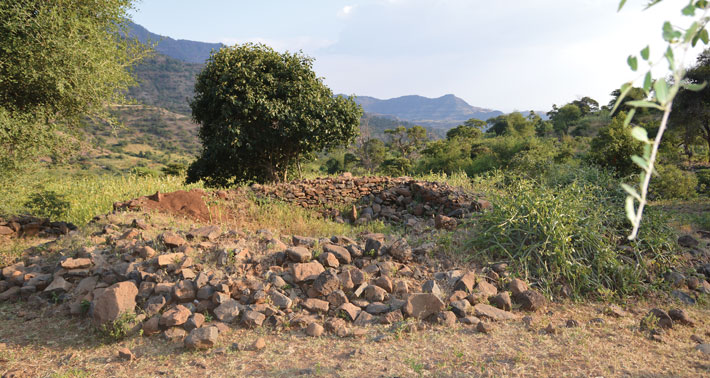 The researchers have relied heavily on the memories of both the Beta Israel and present-day residents of northern Ethiopia to find the locations they have surveyed and to determine which earlier structures were used by the community and for what purpose. For example, in Semien Menata, where the team has documented the remnants of two prayer houses, two cemeteries, and several homes that belonged to the Beta Israel, there were few symbols associating these features with Jews. But the village’s current residents, as well as the Beta Israel who once lived there, agree that the remnants are from the Jewish community. Ethiopian sources going back to the fifteenth century also mention that the area was home to Jews. “If you put the written, oral, and archaeological sources together, they indicate the community was here starting at least six hundred years ago,” says team member Zaroui Pogossian, a professor of Byzantine civilization at the University of Florence. “In situations like this, you need to bring these sources together and give each equal attention, taking whatever each one can give you.”
The researchers have relied heavily on the memories of both the Beta Israel and present-day residents of northern Ethiopia to find the locations they have surveyed and to determine which earlier structures were used by the community and for what purpose. For example, in Semien Menata, where the team has documented the remnants of two prayer houses, two cemeteries, and several homes that belonged to the Beta Israel, there were few symbols associating these features with Jews. But the village’s current residents, as well as the Beta Israel who once lived there, agree that the remnants are from the Jewish community. Ethiopian sources going back to the fifteenth century also mention that the area was home to Jews. “If you put the written, oral, and archaeological sources together, they indicate the community was here starting at least six hundred years ago,” says team member Zaroui Pogossian, a professor of Byzantine civilization at the University of Florence. “In situations like this, you need to bring these sources together and give each equal attention, taking whatever each one can give you.”
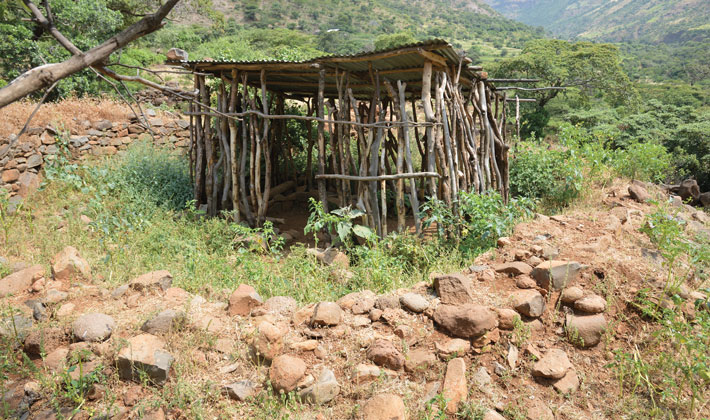 Modern scholars are unsure exactly when and how Ethiopia’s Jewish community originated. A common explanation in the Beta Israel tradition is that the Queen of Sheba, known from the Hebrew Bible, was native to Ethiopia and went to Jerusalem to visit King Solomon, where she became pregnant by him. After her return, she gave birth to a son, Menelik. According to this tradition, Menelik later visited his father in Jerusalem and returned to Ethiopia accompanied by a group of Israelites. These Israelites remained, and some resisted attempts over the years to convert them to Christianity, eventually becoming the Beta Israel, which means the House of Israel in Ge‘ez. Others in the community say they descend from a group that followed the Biblical prophet Jeremiah, or from the lost Israelite tribe of Dan.
Modern scholars are unsure exactly when and how Ethiopia’s Jewish community originated. A common explanation in the Beta Israel tradition is that the Queen of Sheba, known from the Hebrew Bible, was native to Ethiopia and went to Jerusalem to visit King Solomon, where she became pregnant by him. After her return, she gave birth to a son, Menelik. According to this tradition, Menelik later visited his father in Jerusalem and returned to Ethiopia accompanied by a group of Israelites. These Israelites remained, and some resisted attempts over the years to convert them to Christianity, eventually becoming the Beta Israel, which means the House of Israel in Ge‘ez. Others in the community say they descend from a group that followed the Biblical prophet Jeremiah, or from the lost Israelite tribe of Dan.
What is clear is that the community developed in isolation from the rest of the Jewish diaspora. Until the nineteenth century, when they began having wide-scale contact with outsiders, Ethiopian Jews were unaware of rabbinical texts such as the Mishnah and Talmud that form the heart of Jewish practice in the rest of the world. These texts were composed between the third and sixth centuries A.D., long after the Torah was completed, mainly in Israel and Babylon in present-day Iraq, which was a center of Jewish scholarship at the time. The Mishnah and Talmud marked the evolution of Judaism from a religion centered on sacrifice to one based around prayer. Without these texts, the Beta Israel developed their own liturgy and a hierarchy of priests, including the meloksewoch and the qesoch, who had families and lived in the general community.
The earliest known textual references to Jews in Ethiopia date to the ninth century A.D. But, in many texts, especially Christian ones, ayhud, the Ge‘ez word for Jew—which is very similar to the word for Jew in other Semitic languages, including Aramaic, Arabic, and Hebrew—can also refer to those viewed as outcasts. “Ayhud was a sort of catchall term for heretics and anyone who wasn’t seen as in line with church thinking,” says Verena Krebs, a medieval historian at the Institute for Advanced Study. Christianity has long been the dominant religion in the region, as the rulers of the Kingdom of Aksum (ca. A.D. 100–940) were among the first to embrace the religion, founding the Ethiopian Orthodox Church in the fourth century A.D. Persecution of non-Christians increased under the Solomonic Dynasty (1270–1974), which expanded to rule all of Ethiopia. Resisting conversion to Christianity could result in arrest, violence, and loss of the right to own land. Thus, many members of the Beta Israel community became tenant farmers and landless artisans forced to ply crafts such as pottery making, weaving, and metalworking.
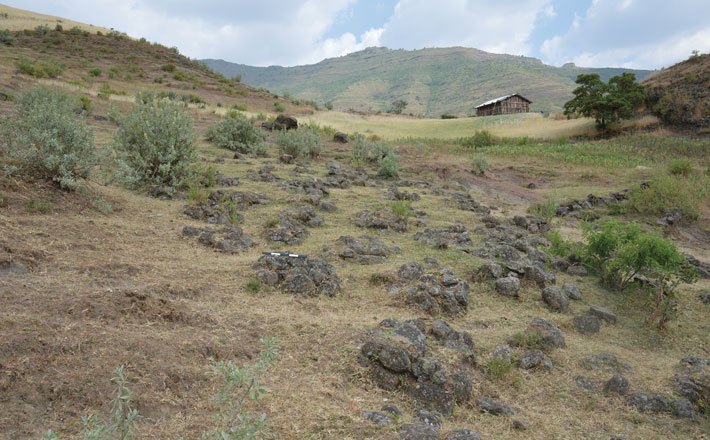 The Solomonic Dynasty claimed a divine right to rule based on a belief akin to that of the Beta Israel—that it descended from the son of the Queen of Sheba and King Solomon. A written account of the purported Christian connection to Solomon appears in the fourteenth-century Ethiopian national epic The Glory of Kings. “Beginning then, we really see the ruling powers and the Church, as well as the Jewish groups, adopt competing claims to the legend of the Biblical Solomon,” says Krebs. “The Ge‘ez word for Israelite was readily and flatteringly employed in medieval Ge‘ez texts to describe those of presumed Solomonic descent who became Christian.”
The Solomonic Dynasty claimed a divine right to rule based on a belief akin to that of the Beta Israel—that it descended from the son of the Queen of Sheba and King Solomon. A written account of the purported Christian connection to Solomon appears in the fourteenth-century Ethiopian national epic The Glory of Kings. “Beginning then, we really see the ruling powers and the Church, as well as the Jewish groups, adopt competing claims to the legend of the Biblical Solomon,” says Krebs. “The Ge‘ez word for Israelite was readily and flatteringly employed in medieval Ge‘ez texts to describe those of presumed Solomonic descent who became Christian.”
 Ethiopian texts dating to the fifteenth century refer to Jewish groups as falasha, a derogatory term that means landless people. The emergence of this term, says Kaplan, likely indicates that it was around this time that various groups practicing Jewish traditions, such as observing the Sabbath on Saturday, coalesced into a more distinct and united group. “The fourteenth to sixteenth century was the period when the Beta Israel developed their cultural identity,” Kaplan says, noting that this is likely when they established their liturgy, sacred books, and traditions such as the asceticism of the meloksewoch. They also began to call themselves the Beta Israel at this time, in part to show that they, not the Solomonic Dynasty, were the true descendants of King Solomon.
Ethiopian texts dating to the fifteenth century refer to Jewish groups as falasha, a derogatory term that means landless people. The emergence of this term, says Kaplan, likely indicates that it was around this time that various groups practicing Jewish traditions, such as observing the Sabbath on Saturday, coalesced into a more distinct and united group. “The fourteenth to sixteenth century was the period when the Beta Israel developed their cultural identity,” Kaplan says, noting that this is likely when they established their liturgy, sacred books, and traditions such as the asceticism of the meloksewoch. They also began to call themselves the Beta Israel at this time, in part to show that they, not the Solomonic Dynasty, were the true descendants of King Solomon.
Written sources and Beta Israel oral history refer to a number of wars with the Solomonic Dynasty between the fifteenth and seventeenth centuries. At the time, the dynasty was expanding into new areas, including those inhabited by the Beta Israel, who were able to maintain political autonomy in a shrinking swath of territory ultimately confined to the Semien Mountains. In the seventeenth century, the capital city of Gondar was founded in northern Ethiopia, and the power of the monarchy increased in the region where the Beta Israel lived. From the mid-nineteenth century on, a range of factors including the activities of Western Jewish emissaries and Christian missionaries led to substantial changes in Beta Israel religious practices. It was mainly in mountainous areas less affected by modernity and less accessible to Western visitors where elements of the community such as the ascetic priesthood managed to survive well into the twentieth century.
The team’s survey has documented a range of sites with remnants of Beta Israel settlements in the remote highlands and fertile plains of northern Ethiopia. In some places where no identifiable evidence of settlement could be found, local residents shared memories of the community’s presence. Much of the evidence the team has identified relates to the meloksewoch, echoing texts and oral history that attest to the essential role they played in Beta Israel society. For instance, at Semien Menata, one of the two prayer houses identified by the team was once part of a compound that was enclosed within a stone wall with a pair of gaps where gates once stood. One gate was likely used exclusively by the meloksewoch so they could maintain their separation from the general populace. On rare occasions when they came into contact with regular community members, the meloksewoch would purify themselves by immersing themselves in water or changing their clothes. “Understanding the meloksewoch is paramount for understanding how the Jewish community worked and how they survived for so many years under the hardship of persecution and wars,” Kribus says.
 The Beta Israel oral tradition places the birth of its ascetic movement in the Semien Mountains in the fifteenth century and suggests that the meloksewoch revitalized the broader Jewish community and helped ensure its survival. According to oral tradition written down in the nineteenth century, the first melokse, or high priest, was a fifteenth-century holy man named Abba Sabra, who, after being taken prisoner by the forces of the Solomonic Dynasty, committed himself to a life of religious contemplation, celibacy, and teaching in hopes that doing so would protect his people from persecution and the threat of conversion to Christianity. Abba Sabra continued to be seen as a respected spiritual leader for centuries after his death. “God sent Abba Sabra to us so that the religion of Moses and the laws of the Torah would not disappear,” writes a twentieth-century Beta Israel priest named Abba Yeshaq Iyasu.
The Beta Israel oral tradition places the birth of its ascetic movement in the Semien Mountains in the fifteenth century and suggests that the meloksewoch revitalized the broader Jewish community and helped ensure its survival. According to oral tradition written down in the nineteenth century, the first melokse, or high priest, was a fifteenth-century holy man named Abba Sabra, who, after being taken prisoner by the forces of the Solomonic Dynasty, committed himself to a life of religious contemplation, celibacy, and teaching in hopes that doing so would protect his people from persecution and the threat of conversion to Christianity. Abba Sabra continued to be seen as a respected spiritual leader for centuries after his death. “God sent Abba Sabra to us so that the religion of Moses and the laws of the Torah would not disappear,” writes a twentieth-century Beta Israel priest named Abba Yeshaq Iyasu.
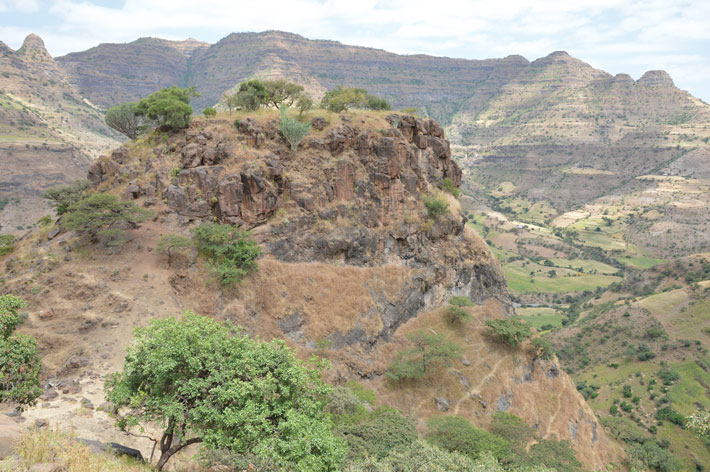 During the fifteenth and sixteenth centuries, the meloksewoch established a network of monastic centers in and outside Beta Israel villages. At many of the sites they surveyed, the team identified remnants of circular prayer houses, in which the meloksewoch and qesoch conducted rituals. Some written accounts refer to internal walls in the prayer houses, separating areas used by the meloksewoch from those used by others. None of the foundations of prayer houses surveyed had visible internal walls, though many did have multiple entrances. Kribus notes that many of the prayer houses seem too small to have held the general community along with the meloksewoch. “It could have been that only the meloksewoch, and maybe the other priests and elders, prayed inside, and the rest were outside,” he says. “That would also have made it easier for the meloksewoch to maintain their state of purity.”
During the fifteenth and sixteenth centuries, the meloksewoch established a network of monastic centers in and outside Beta Israel villages. At many of the sites they surveyed, the team identified remnants of circular prayer houses, in which the meloksewoch and qesoch conducted rituals. Some written accounts refer to internal walls in the prayer houses, separating areas used by the meloksewoch from those used by others. None of the foundations of prayer houses surveyed had visible internal walls, though many did have multiple entrances. Kribus notes that many of the prayer houses seem too small to have held the general community along with the meloksewoch. “It could have been that only the meloksewoch, and maybe the other priests and elders, prayed inside, and the rest were outside,” he says. “That would also have made it easier for the meloksewoch to maintain their state of purity.”
Beta Israel oral history suggests that the meloksewoch lived in huts near the prayer house. These huts were often surrounded by lines of stones on the ground so others would know not to enter. In Qolqwaloch, a Beta Israel village near Semien Menata, the team identified a small circular structure in the prayer house compound that could have served as a separate place for the high priests to pray. One Beta Israel elder recalls that the meloksewoch would bless people through a window in this structure. The researchers also located the foundations of another hut where the qesoch may have lived.
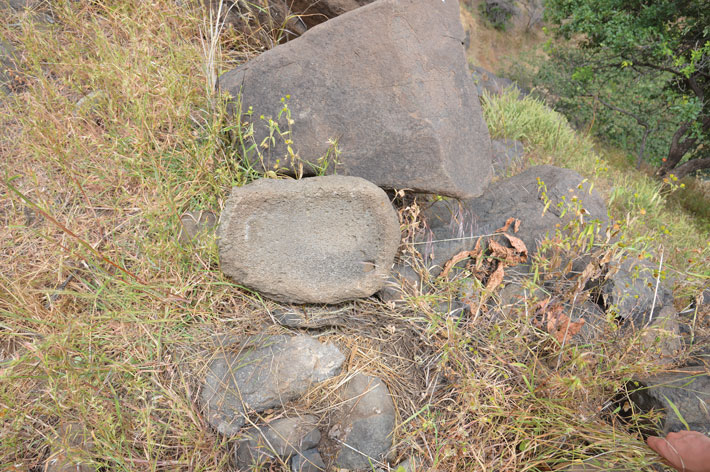 Places where the meloksewoch lived, experienced notable events, or were buried often became pilgrimage destinations for the Beta Israel. For example, a religious leader named Abba Gan is believed to have lived and been buried on a hilltop at the foot of the Zawila Ridge, below the Wagara Plateau, separate from any known Beta Israel villages. This hilltop became among the best-known Beta Israel holy sites. The team surveyed the hilltop and found evidence of an enclosure, as well as basalt grinding stones, which members of the Beta Israel community say were used to prepare food by those who made the pilgrimage there. These pilgrims would purify themselves by eating raw chickpeas and immersing themselves in water. A Beta Israel woman named Mucet Makwannen, who says she was healed of an illness at the site before migrating to Israel, explained the ritual to researchers. “One eats chickpeas, peas, and broad beans without cooking them,” she said. “They are eaten with a little salt until one has a good or bad dream. If these things are not observed, one is shown in the dream bad animals, dangerous reptiles. If one goes clean and pure, one has good dreams and returns home healthy and whole.”
Places where the meloksewoch lived, experienced notable events, or were buried often became pilgrimage destinations for the Beta Israel. For example, a religious leader named Abba Gan is believed to have lived and been buried on a hilltop at the foot of the Zawila Ridge, below the Wagara Plateau, separate from any known Beta Israel villages. This hilltop became among the best-known Beta Israel holy sites. The team surveyed the hilltop and found evidence of an enclosure, as well as basalt grinding stones, which members of the Beta Israel community say were used to prepare food by those who made the pilgrimage there. These pilgrims would purify themselves by eating raw chickpeas and immersing themselves in water. A Beta Israel woman named Mucet Makwannen, who says she was healed of an illness at the site before migrating to Israel, explained the ritual to researchers. “One eats chickpeas, peas, and broad beans without cooking them,” she said. “They are eaten with a little salt until one has a good or bad dream. If these things are not observed, one is shown in the dream bad animals, dangerous reptiles. If one goes clean and pure, one has good dreams and returns home healthy and whole.”
Another holy site surveyed by the team is Gwang Ras, which they located based on recently published accounts from members of the Beta Israel community. The site is home to springs on the fertile plains outside Gondar that are the source of the Gwang River, which snakes through Ethiopia and Sudan into the Nile. Beta Israel tradition holds that the original melokse, Abba Sabra, stopped at Gwang Ras while fleeing from the fifteenth-century Solomonic king Zar’a Ya‘eqob. The site subsequently became a place of pilgrimage, where miracles are believed to have occurred. Researchers found that the soil at Gwang Ras was a variety of bright colors, including red. A Beta Israel story tells of meloksewoch applying red mud to the head of a woman who came there after losing seven children to illness. She later bore another seven children, all of whom were healthy.
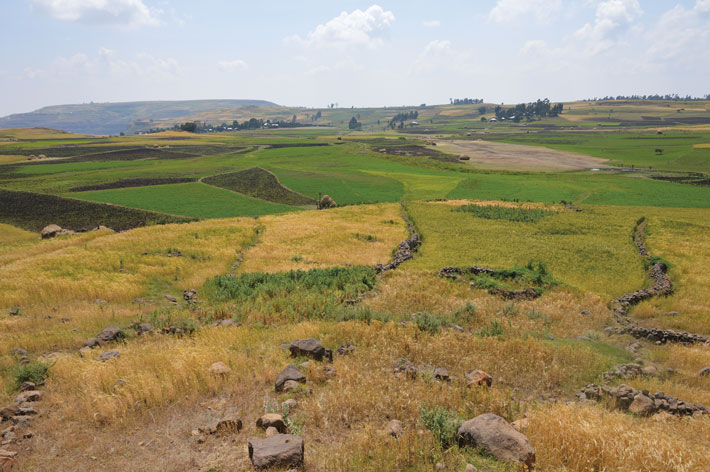 When Gondar, in northern Ethiopia’s highlands, was established as the capital in 1632, many members of the Beta Israel community were enlisted to help build the city. These Jews, who had lost their farmland when the monarchy limited land ownership to Christians, found lucrative outlets for their craft skills, increasing their standing in society. A 2007 excavation of Beta Israel living quarters and workshops in Abwara, a village on the outskirts of Gondar, led by archaeologist Rebecca Klein, then of the University of Florida, unearthed only a few examples of simple pottery dating to when Gondar became the capital. This suggests that at this time the Beta Israel turned their attention away from traditional crafts and toward skilled arts such as masonry and building.
When Gondar, in northern Ethiopia’s highlands, was established as the capital in 1632, many members of the Beta Israel community were enlisted to help build the city. These Jews, who had lost their farmland when the monarchy limited land ownership to Christians, found lucrative outlets for their craft skills, increasing their standing in society. A 2007 excavation of Beta Israel living quarters and workshops in Abwara, a village on the outskirts of Gondar, led by archaeologist Rebecca Klein, then of the University of Florida, unearthed only a few examples of simple pottery dating to when Gondar became the capital. This suggests that at this time the Beta Israel turned their attention away from traditional crafts and toward skilled arts such as masonry and building.
In more remote areas, however, the meloksewoch tradition remained strong. As of the late seventeenth century, the Beta Israel religious center of Hoharwa is believed to have been home to more than 250 high priests, but just one of dozens of locals the team spoke with knew anything about it. This once-thriving monastic community seems to have disappeared in the early twentieth century, says Kribus, underscoring the decline of the Beta Israel that began in the nineteenth century, largely due to famine and the influence of Christian missionaries and Jewish activists from the West. These were among the first foreigners who visited the ascetic communities starting in the 1860s and recorded their encounters, including how the meloksewoch attempted to remain pure. One of these visitors, a Christian missionary named Henry Aaron Stern, reported that the high priests would not touch a Bible or other gifts he had brought, asking him to set the objects down rather than directly hand them over. By the early twentieth century, the numbers of meloksewoch had dropped significantly compared with accounts recorded just a few decades earlier. With the decline of the meloksewoch, the qesoch replaced them in the religious leadership and took charge of educating and consecrating the next generation of priests.
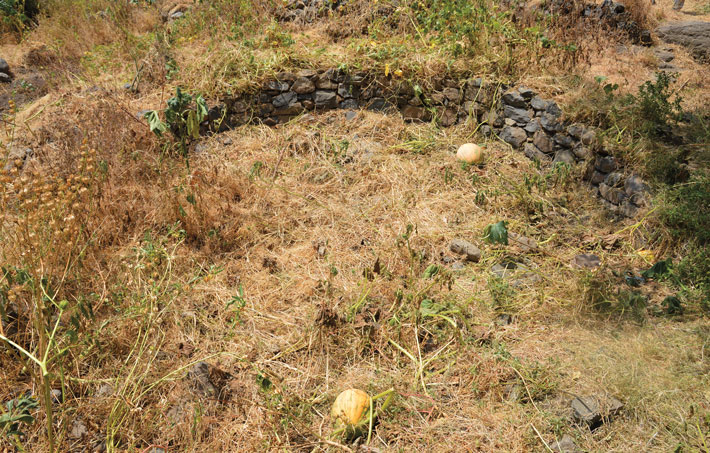 The Beta Israel living in and around Gondar experienced reduced demand for their skills in the nineteenth century after the city was sacked by rebel forces and the Solomonic Dynasty moved their capital east to Mekele in the 1880s. Klein’s excavation at Abwara found that the volume and diversity of pottery sherds increased sharply at this time, evidence that the Beta Israel in the Gondar area were once again forced to sell pots to make a living.
The Beta Israel living in and around Gondar experienced reduced demand for their skills in the nineteenth century after the city was sacked by rebel forces and the Solomonic Dynasty moved their capital east to Mekele in the 1880s. Klein’s excavation at Abwara found that the volume and diversity of pottery sherds increased sharply at this time, evidence that the Beta Israel in the Gondar area were once again forced to sell pots to make a living.
Semien Menata was the last community in Ethiopia that was home to meloksewoch, who remained there into the 1970s. Beginning in the mid-twentieth century, meloksewoch from other locations moved to the village, likely prompted by a desire to live alongside fellow high priests. Beta Israel elders now living in Israel told Kribus that, in the twentieth century, the meloksewoch of Semien Menata owned land and grew wealthy, in part from collecting a biblically decreed tithe that community members paid in the form of harvested wheat and firstborn calves. The elders recounted that the meloksewoch often prepared bread, stew, and beer and left them just outside their compound so children or others in need could partake without violating the high priests’ pure state.
Having migrated to Israel over the past four decades, the Beta Israel are now a fading memory in Ethiopia, and the team was unable to find several Beta Israel sites that travelers documented as recently as the mid-twentieth century. In some locations, including the village of Doro Wuha, which the researchers did survey, the land was redistributed after the Beta Israel emigrated, and most dwellings were torn down to make more space for fields. Some residents told the team that stones from these dwellings were reused to build new homes for local families. “We are running out of time to study the material remains of this community and to record oral memories, as fewer people remain from the generations that once lived in Ethiopia,” Kribus says. “There is a lot more work to do, including excavations, but at least we now have a map and a place to start.”
Sara Toth Stub is a journalist based in Jerusalem.